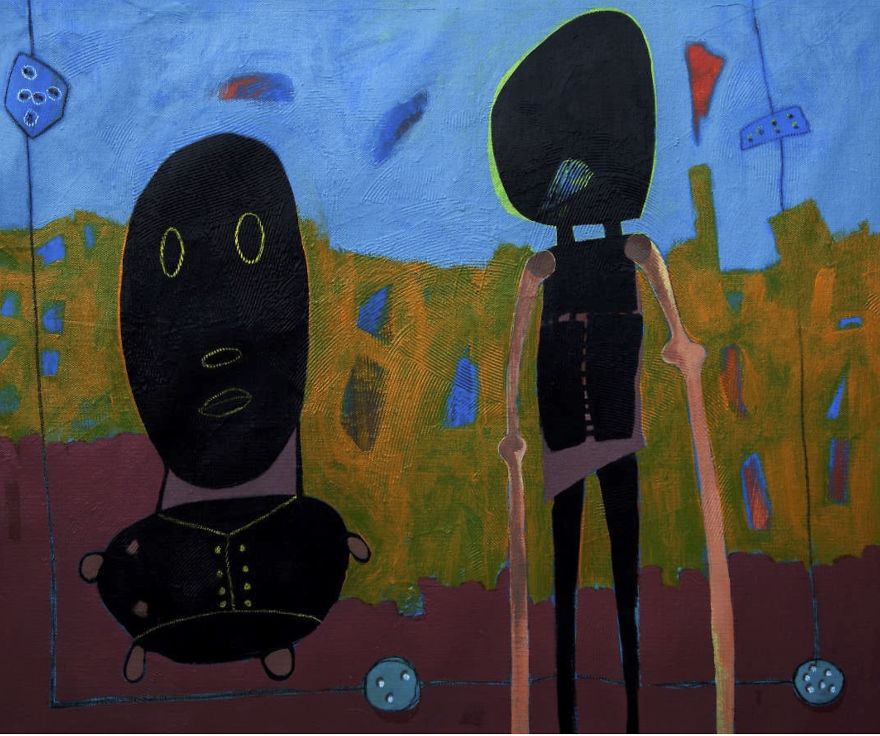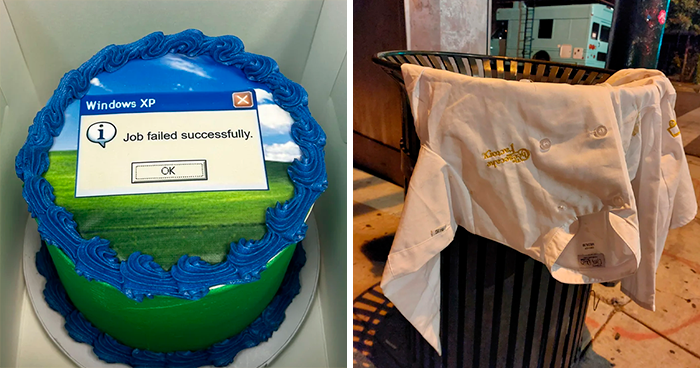A young artist in the contemporary scene in Cairo, Ahmed Gaafari (born 1987) has had quite an extensive career. With over 90 exhibitions on his belt and work ranging from painting, installation, and video art this young artist tackles an array of subjects stretching from abstract and spiritual concepts to direct reactions to political happenings. The artist was – like many other artists of his generation – affected and inspired by Egypt’s revolution which saw its way into his work. While he had always had a preference for classical mediums such as painting and sculpture with politics never being a subject he tackled, 2011 came and changed both his medium and subject matter. The artist has been recently focused on creating interactive installations with a political subtext and well as experimenting with video art and collective work.
Gaafary comes from a long line of art dealers. His family has been involved in dealing with paintings for several generations in Luxor. His grandfather expanded the business to Cairo, where the artist was born. He was raised among painters working on duplicating orientalist paintings and being subjected through the family business to art by Egyptian artists such as Seif Wanly and Abdelhady El Gazzar. While it was natural for the young painter to study in the Faculty of Fine Arts, he was unable to enter due to his low scores in High School. When his grandfather died, and so he ended up studying Information Systems while taking classes in the Fine Arts School in the evening. However, in spite of this bump on the road, in retrospect, the artist is glad he took this path. Due to his reservation on the art education system in Egypt, he feels he managed to get what he needed to develop his art without getting sucked into the system. “The education system kills the creative energy turning students into machines, not innovators,” he says stressing that of course there are exceptions to this rule.
Gaafary has been exhibiting since he was in high school. His first exhibition in 2000 was in a gallery called Van Gogh in Heliopolis. The artist was very taken by Van Gogh’s artwork and the array of mysterious stories surrounding him. From a photograph from the archives, Gaafary created a portrait of the artist – much like the self-portraits Van Gogh would paint – in homage to him. According to Gaafary, this painting was sold there and then and he did not even have a photograph of it. From then on Gaafary continued painting and exhibiting his work in private galleries in Cairo that sold art pieces and selected furniture. It was not until later that he started exhibiting in more curated contexts and art spaces.
Most of the artist’s earlier work was an attempt to capture beauty.
To him, beauty is not merely romantic landscapes or aesthetic appeal, but rather the details of beauty in life, of inner beauty. Gaafary is also affected by Sufi tendencies where he tries to capture the soul of the objects or people he tackles. For a long time, he was concerned with portraiture. He focused on applying himself to reach his best abilities to capture details of human faces especially regarding how time affects a person.
All this was encapsulated during his first group exhibition in 2005 at the Fine Arts Faculty when he showed a series of these portraits. The following year, in 2006 in Cairo Atelier, he exhibited portraits that were devoid of the previously rich colors and details, experimenting with his technique further. From this point until the outbreak of the Egyptian revolution, Gaafary participated in several group exhibitions as well as hosted three solo shows of painting work further exploring the same subject matter of inner beauty. Following a symposium the artist took part in for the Mediterranean region, the artist went on to create seventeen paintings portraying the sea and the fishermen’s relation to it. The work was meant to be exhibited in Alexandria, then Cairo and Minya, but unfortunately, it never saw the light of a gallery space. While at first the exhibition was postponed due to terrible weather conditions in Egypt’s coastal city in December 2010, it was then postponed once more due to the Saints Church bombings on new year’s eve, and finally, it was postponed indefinitely with the outbreak of the revolution.
At the beginning of Egypt’s revolutionary year, the artist, like many of his counterparts, was not inclined to produce work. It was a difficult time for artists, many felt any work on the happenings would be too soon with the consistently changing events while at the same time finding it difficult to produce work on anything else. Gaafary, however, decided it would be best to challenge himself to work directly on the subject of the revolution using an entirely novel medium to him: interactive installation. Even though he was always very insistent on more classical approaches to art such as painting or sculpture “perhaps due to my ignorance at the time,” he admits. After the revolution, he felt the events were too quick to be portrayed in painting or sculpture and felt these mediums would suffocate his vision at the time. In 2011, Gaafary took part in the Youth Salon at the Palace of the Arts inside the Cairo Opera House, which is run by the Ministry of Culture. ‘The Beginning Project’ was four graphic design posters created as almost replicas of the document one gets after they have a police check for a criminal record. Each poster had a photograph of the artist but as four different characters: an army soldier, an Islamist, a revolutionary and a member of the “Couch Party” which was the term given to the people who were not participating in the revolution. In front of these posters lay a see-through glass box where viewers could cast their ballot for which direction they would like the country to go in.
However, there was a twist. The box had a slot to place the votes that were seemingly there but in fact, it was shut. So even though there was the illusion of democracy the ballot box was closed and the results pre-decided. This commentary on the lack of a real revolution was particularly important to the artist not only due to the work itself but because it was exhibited within a governmental institution such as the Palace of the Arts. Gaafary’s next project was in 2012 in Saad Zaghloul Culture Centre entitled ‘Made in Egypt’. In this exhibition, the artist mainly used two video artworks to show how the regime was creating an illusion of problems such as traffic, increasing prices and low shortage of bread and gas to distract the people from the crucial issues happening.
Over the next two years, Gaafary’s interest in politics and its peripheral issues only grew. Later in 2012, he exhibited ‘Way to Infinity’ which was a video art project that featured footage of crowds walking through Cairo’s crowded streets with sound bites from an Islamist preacher. “The project is about how the society builds a sexual harasser,” the artist explains. The artist was inclined to dive into the relationship between the media presented to youth in Egypt – from Turkish soap operas to sermons on sex – and how it relates to how young men become sexual harassers in the city. ‘Way to Infinity’ was also exhibited in Saad Zaghloul Culture Centre then was shown in Oslo, Norway.
In the 2013 Youth Salon in Cairo, Gaafary participated with another interactive installation. In ‘The Prison Project’ the artist occupies an entire room, covering its walls with newspapers. A small window takes up space on one side of the room, illuminated by the gallery lights in a fashion that would highlight a person’s features. Viewers would then, out of curiosity, go look out the window, behind the bars they are faced with their reflection in a mirror. “The project is about how each of us can be a prisoner of his conviction, thoughts, religion, or anything in their life; as Egyptians, we are even imprisoned because of our nationality,” the artist says. “It is meant to evoke an internal debate where the viewer asks himself: What is the prison within me?” Nowadays, the artist is taking a step back from his politically charged works of video and installation and delving back into painting. Continuing his attempts to capture inner beauty, Gaafary is exploring the human being from the inside, literally. He examines human cells and how they react with each other when a person is in various emotional states. He then translates these reactions into paintings of a more abstract nature in his in-production series: Primitive Life.
Ahmed Gaafary is an artist not afraid to break out his comfort zone and explore various means of expression. The level of conceptualization and research in his works are evident to the naked eye.
JM Art Management
info@jmartmanagement.com
About the writer:
Rowan El Shimi is a culture journalist using writing, photography, and video for reporting, featuring and analyzing Egyptian cultural scene. She is also interested in social development and concerned particularly with its relationship with the arts. You can follow her work at www. rowanelshimi.org
More info: jmartmanagement.com
Untitled
Image credits: www.artsy.net
Untitled , 2019
Acrylic & oil pastel on canvas
31 × 39 in
78.7 × 99.1 cm
Untitled
Image credits: www.artsy.net
Untitled , 2019
Acrylic & Oil Pastel on Canvas
43 × 39 in
109.2 × 99.1 cm
Untitled
Image credits: www.artsy.net
Untitled
Image credits: www.artsy.net
Untitled , 2019
Acrylic on canvas
78 × 78 in
198.1 × 198.1 cm
Untitled
Image credits: www.artsy.net
Untitled , 2018
Acrylic on canvas
59 × 59 in
149.9 × 149.9 cm
Untitled
Image credits: www.jmartmanagement.com

 Dark Mode
Dark Mode 

 No fees, cancel anytime
No fees, cancel anytime 

































1
0